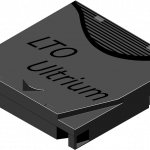Nobody knows what to do with storage tapes
A tape drive is a data storage device that reads and writes data on a magnetic tape. Magnetic tape data storage is typically used for offline, archival data storage. Magnetic tape drives with capacities of less than one megabyte were first used for data storage on mainframe computers in the 1950s. By 2018, capacities of 20 terabytes or higher of uncompressed data per cartridge were available.
Magnetic tape is commonly housed in a casing known as a cassette or cartridge—for example, the 4-track cartridge and the Compact Cassette. The cassette contains magnetic tape to provide different audio content using the same player. The outer shell, made of plastic, sometimes with metal plates and parts, permits ease of handling of the fragile tape, making it far more convenient and robust than having spools of exposed tape.
Many times, the tape drive used to access the tapes is not even used anymore, having been replaced with newer technology. The storage tapes then sit on a shelf or in a box. They can’t be thrown out, because they still contain data, even if it’s old.
So what to do with storage tapes?
- You can give them to a recycler who will take them for free. Hopefully they will wipe the data and resell them. Hopefully.
- You can give them to a technology disposal company who will shred the tapes, rendering them completely unrecoverable.
Completely Unrecoverable.
If you don’t know what to do with storage tapes, ask yourself this question:
Is anything valuable on those tapes? If not, the first choice should be fine. but if whatever is on those tapes isn’t valuable, what was being backed up? Client information? Employee information? Research and Development? Banking information? Correspondence? Scanned documents? All of those can be damaging if even one tape gets resold with information still accessible.
Read more about our tape shredding.
Recycling vs. Shredding
There is no available technology that can recycle used tapes. Recycling of tapes means “Reuse”. The reuse of tapes must require that all of your recorded data be erased prior to resale. There is no 100% effective method of erasing tapes other than degaussing and degaussing destroys a tape drive’s ability to read/write on the tape. Reformatting a degaussed tape is prohibitively expensive. Most tape erasure tools (other than degaussing) use tape overwrite techniques. Tape overwriting will not occur on surface areas of the tape that the recording heads identify as defective. Those areas can retain prior recorded data.

